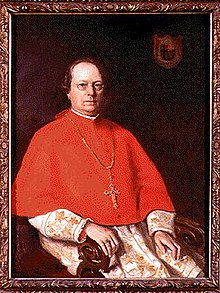Papal Legate
The legate ( papal or apostolic ) , as ambassador of the Holy See, represents the authority of the Pope and acts on his behalf. The name is derived from the Roman title of Legatus ("[ex officio] envoy"). In the Middle Ages he safeguarded the interests of the Pope at royal courts and also pronounced excommunications . Legates could also make decisions about the organization of the church, for example setting up dioceses and archbishoprics. The immediate representative of the Pope is also referred to as Legatus a latere .
Honorary title
The archbishops of Salzburg , Gniezno / Gnesen , Gran / Esztergom-Budapest , Cologne and Prague bear the honorary title of "born legate" ( Latin legatus natus ). They are therefore entitled to wear the “legacy purple” (but only within their own archdiocese / diocese) if they are not cardinals anyway. The Archbishop of Salzburg, however - due to his dignity as Primate Germaniae - may wear the legacy purple everywhere. The same has recently been the case for the Archbishop of Gniezno , who is both Legatus natus and Primate Poloniae . The so-called “legate purple” is more recently the color of the scarlet red official and choir clothing of a born legate of the cardinals . Originally the purple was a dark purple, slightly reddish-tinged garment.



history

The Roman bishops had been represented by apostolic legates or envoys with special assignments at local and general councils , such as the Council of Arles in 314 , from the 4th century onwards . Between the 4th and 8th centuries, the popes sent permanent legates, a so-called Apocrisiar , to the imperial court in Constantinople . Every now and then a legacy was set up at the Exarchate of Ravenna to represent the interests of the Church and the State. In parts of early modern Church State legate were as governor used the papal central authority, provided that such parts of the country not to feud had been given. The best-known example of this are the former papal legations of Bologna , Ferrara and Ravenna , which have been in legitimate possession of Rome since the Pippin donation .
In addition to the diplomatic legates, apostolic vicars were also appointed who were given extraordinary papal authority in special church provinces . From this later developed the function of the primate , who ranked immediately behind the patriarch . The mission legates, who were entrusted with very specific tasks for a given area, played another important role. Augustine of Canterbury for Anglo-Saxons and Boniface for Germania should be emphasized here .
In the 11th and 12th centuries the apostolic legates were elevated to cardinals and accepted into the college of cardinals . This high ecclesiastical rank was an upgrade and underlined the importance of the tasks, but it also led to conflicts through the powers that the legate was entitled to under canon law . The embassy system experienced its first high point in the 16th century, Pope Gregory XIII. (1572–1585) had installed permanent legates to enforce the reform decisions of the Council of Trent (1545–1563) who, in addition to their diplomatic missions, also acted as liaisons to the Curia . It emerged nunciatures with a fixed seat and intended to be permanent, the first facilities were in Venice , Vienna , Cologne , Graz and Lucerne . The papal nuncios sometimes developed such a high dynamic of their own that they partially outvoted the metropolitan. As is well known, this gave rise to Gallicanism , Febronianism , the Emser punctuation and the Munich nunciature dispute of 1785. At the Vienna Congress in 1815 , the papal nuncios were placed on an equal footing with state ambassadors.
After the Second Vatican Council
On the basis of the dogmatic constitution Lumen Gentium put Pope Paul VI. (1963–1978) with the papal bull Sollicitudo omnium ecclesiarum of November 21, 1964, the tasks and the service of the papal legates. Now qualified laypeople could also be deployed in papal missions.
See also
Web links
- Sollicitudo omnium ecclesiarum by Paul VI. , 1969. Text of the Papal Letter (Motu proprio) (Italian)
- Nuncio (English)
